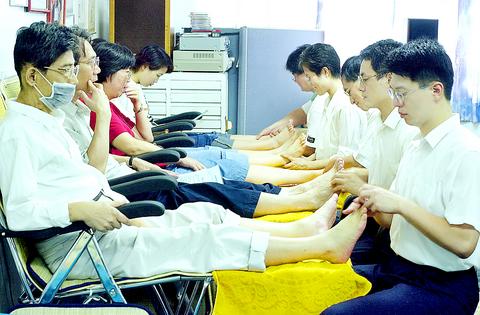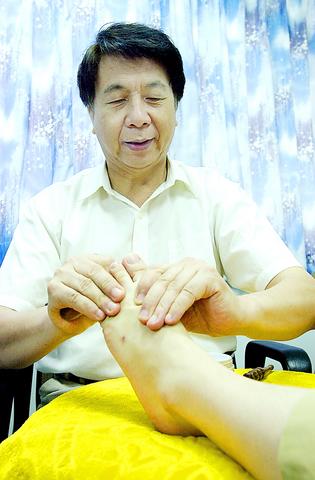Inside the long storefront windows lie a row of big comfortable couches on which a dozen customer are reclined. In front of them, massage therapists are concentrating on their customers' feet. Using only their hands, a wooden massage bat and some cream, they swiftly press, push and rub. Some of their Japanese customers give out groans of pain -- "Itai! Itai! Itai!" -- but most customers, foreign or local, seem to enjoy it. Three young Japanese women take pictures of each other while being massaged, their fingers stretched in a "V" gesture while their faces remain pinched in pain.
"Taiwanese foot massage is very famous in Japan. I heard it's more painful than in Thailand and other countries. I like it," said 24 year-old Yasuko Shishido.

Shishido was in Taipei for just a day and kept busy tasting local dumplings, sampling Oolung tea and pineapple cakes and was eager to get in a foot massage before having to leave Taiwan.

PHOTO: CHEN CHENG-CHANG, TAIPEI TIMES
"I come to Taiwan for business twice a year and always come here, however busy my trip," said 60-year-old Tuneo Iwane, another Japanese customer at this foot massage parlor.
For many Japanese tourists, Taiwan's attractions aren't only the Palace Museum and Chiang Kai-shek Memorial Hall, but the masochistic pleasure of foot massage.

PHOTO: CHEN CHENG-CHANG, TAIPEI TIMES
Walking along Taipei's Minchuan East Road or Linsen North Road, there can be seen more than a dozen foot massage parlors, each with a huge, eye-catching sign of a colorfully diagrammed foot. Many of them bear the name Father Wu Foot Massage.
Father Josef Eugster from Switzerland, who goes by the Chinese name Wu Ro-shih (吳若石), said the parlors and their popularity are something he would never have thought of 23 years ago, when foot massage was a simple self-help therapy. It was more than two decades ago when he "re-discovered" and began promoting the practice that can be found in the ancient histories of China and Egypt, a therapy known as foot reflexology.
A month ago he held a press conference clarifying to the public for the first time that he had never authorized anyone to use his name as a trademark, nor is the colorful foot diagram of his making. The phenomenal success of foot reflexology in Taiwan makes Eugster proud, but at the same time worried.
After arriving in Taiwan 30 years ago to preach in Taitung, Eugster became bothered by arthritis. Another Swiss priest gave him a book about foot reflexology titled Good Health for the Future (1976), by Heidi Masafret. He studied the book and experimented on himself. Pleased with the results, he began practicing on his disciples to help them with their own health problems, but also as a way to spread the gospel.
According to theories expounded on by Eugster and Eugene Cheng (
Reflexology theory divides the foot into 26 bones and five major reflex areas. To massage the foot is to stimulate the problematic organs or "push away the pathological sediments," Eugster said.
Cheng also combines reflexology theory with Chinese medicine's five-elements concept in practicing foot massage. For example, if one feels pain or sediment when pressing on one part of the left sole (see diagram, area 33), it is an indication of a heart problem. According to the five-elements theory, the heart belongs to the fire element, so in addition to the heart, the reflex areas of the intestine and liver must also be massaged in order to maintain a healthful balance.
After considerable local and international media coverage 20 years ago, Eugster gained fame and a flock of foot-massage followers. Shuttling from workshops to hospitals and speaking engagements, the fruit of Eugster's work can be seen in nearly every city in Taiwan, with around 1,000 foot massage parlors on the island, according to Cheng. And it's become more popular, losing its focus on therapy and becoming more of a superficial consumer fad.
It's also become a huge money-making enterprise lacking in regulation. Some parlors have developed into multi-function health centers. In addition to offering foot massage, one parlor called Tsai Chun Kuan (
Tsai Chun Kuan has also contracted with several travel agencies to bus tourists directly to the parlor. Tourists pay NT$700 for a half-hour foot massage, NT$200 of which goes to the travel agents. For Japanese, it's still a reasonable price compared with what they would pay in Japan.
Currently in Taiwan, the price for a foot massage is between NT$500 and NT$700 for 30 minutes. There is no regulation of price or quality, which can vary widely.
Lu Wan-ping (
Since 1984, the Cabinet-level Department of Health (
The ROC Foot Reflexology Association, founded by Cheng and Eugster, is the only group in Taiwan that certifies massage therapists in their chosen trade. But there remains a void of institutionalization on the correct practice and technique of foot reflexology, according to Cheng.
"If they want to use my name, they have to employ my standard of skill and quality of practice," Eugster said. "I'll have to train them myself."

Oct. 27 to Nov. 2 Over a breakfast of soymilk and fried dough costing less than NT$400, seven officials and engineers agreed on a NT$400 million plan — unaware that it would mark the beginning of Taiwan’s semiconductor empire. It was a cold February morning in 1974. Gathered at the unassuming shop were Economics minister Sun Yun-hsuan (孫運璿), director-general of Transportation and Communications Kao Yu-shu (高玉樹), Industrial Technology Research Institute (ITRI) president Wang Chao-chen (王兆振), Telecommunications Laboratories director Kang Pao-huang (康寶煌), Executive Yuan secretary-general Fei Hua (費驊), director-general of Telecommunications Fang Hsien-chi (方賢齊) and Radio Corporation of America (RCA) Laboratories director Pan

President William Lai (賴清德) has championed Taiwan as an “AI Island” — an artificial intelligence (AI) hub powering the global tech economy. But without major shifts in talent, funding and strategic direction, this vision risks becoming a static fortress: indispensable, yet immobile and vulnerable. It’s time to reframe Taiwan’s ambition. Time to move from a resource-rich AI island to an AI Armada. Why change metaphors? Because choosing the right metaphor shapes both understanding and strategy. The “AI Island” frames our national ambition as a static fortress that, while valuable, is still vulnerable and reactive. Shifting our metaphor to an “AI Armada”

When Taiwan was battered by storms this summer, the only crumb of comfort I could take was knowing that some advice I’d drafted several weeks earlier had been correct. Regarding the Southern Cross-Island Highway (南橫公路), a spectacular high-elevation route connecting Taiwan’s southwest with the country’s southeast, I’d written: “The precarious existence of this road cannot be overstated; those hoping to drive or ride all the way across should have a backup plan.” As this article was going to press, the middle section of the highway, between Meishankou (梅山口) in Kaohsiung and Siangyang (向陽) in Taitung County, was still closed to outsiders

The older you get, and the more obsessed with your health, the more it feels as if life comes down to numbers: how many more years you can expect; your lean body mass; your percentage of visceral fat; how dense your bones are; how many kilos you can squat; how long you can deadhang; how often you still do it; your levels of LDL and HDL cholesterol; your resting heart rate; your overnight blood oxygen level; how quickly you can run; how many steps you do in a day; how many hours you sleep; how fast you are shrinking; how